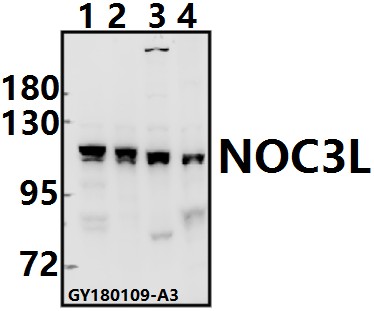Product Name :
NOC3L (F447) polyclonal antibody Background :
GADD 153, a growth arrest and DNA damage-inducible gene, encodes a C/EBP-related nuclear protein. This protein has also been designated C/EBP-homologous protein (CHOP-10 or C/EBP zeta). GADD 153 expression is induced by a variety of cellular stresses, inducing nutrient deprivation and metabolic perturbations. GADD 153 functions to block cells in G1 to S phase during cell cycle progression and acts by dimerizing with other C/EBP proteins to direct GADD 153 dimers away from “classical” C/EBP binding sites, recognizing instead unique “nonclassical” sites. Thus, GADD 153 acts as a negative modulator of C/EBP-like proteins in certain terminally differentiated cells. GADD 153 belongs to the CBF/MAK21 family, which also includes NOC2L, NOC3L and NOC4L. NOC3L, also designated factor for adipocyte differentiation 24 or Fad24, promotes adipogenesis by controlling DNA replication during the early stages of mitotic clonal expansion (MCE). Product :
Rabbit IgG, 1mg/ml in PBS with 0.02% sodium azide, 50% glycerol, pH7.2 Storage&Stability :
Store at 4°C short term. Aliquot and store at -20°C long term. Avoid freeze-thaw cycles. Specificity :
NOC3L (F447) polyclonal antibody detects endogenous levels of NOC3L protein. Immunogen :
Synthetic peptide, corresponding to amino acids 417-436 of Human NOC3L. Conjugate :
Unconjugated Modification :
Unmodification
NOC3L (F447) polyclonal antibody Background :
GADD 153, a growth arrest and DNA damage-inducible gene, encodes a C/EBP-related nuclear protein. This protein has also been designated C/EBP-homologous protein (CHOP-10 or C/EBP zeta). GADD 153 expression is induced by a variety of cellular stresses, inducing nutrient deprivation and metabolic perturbations. GADD 153 functions to block cells in G1 to S phase during cell cycle progression and acts by dimerizing with other C/EBP proteins to direct GADD 153 dimers away from “classical” C/EBP binding sites, recognizing instead unique “nonclassical” sites. Thus, GADD 153 acts as a negative modulator of C/EBP-like proteins in certain terminally differentiated cells. GADD 153 belongs to the CBF/MAK21 family, which also includes NOC2L, NOC3L and NOC4L. NOC3L, also designated factor for adipocyte differentiation 24 or Fad24, promotes adipogenesis by controlling DNA replication during the early stages of mitotic clonal expansion (MCE). Product :
Rabbit IgG, 1mg/ml in PBS with 0.02% sodium azide, 50% glycerol, pH7.2 Storage&Stability :
Store at 4°C short term. Aliquot and store at -20°C long term. Avoid freeze-thaw cycles. Specificity :
NOC3L (F447) polyclonal antibody detects endogenous levels of NOC3L protein. Immunogen :
Synthetic peptide, corresponding to amino acids 417-436 of Human NOC3L. Conjugate :
Unconjugated Modification :
Unmodification
-
 Western blot (WB) analysis of NOC3L (F447) pAb at 1:1000 dilution Lane1:HCT116 whole cell lysate(20ug) Lane2:HepG2 whole cell lysate(20ug) Lane3:AML-12 whole cell lysate(20ug) Lane4:H9C2 whole cell lysate(40ug)
Western blot (WB) analysis of NOC3L (F447) pAb at 1:1000 dilution Lane1:HCT116 whole cell lysate(20ug) Lane2:HepG2 whole cell lysate(20ug) Lane3:AML-12 whole cell lysate(20ug) Lane4:H9C2 whole cell lysate(40ug)
Bioworld Biotech only provide peptides for our antibodies and do not provide additional peptide customization services.
Price/Size :
USD 368/1mg/vial
Tips:
For phospho antibody, we provide phospho peptide(0.5mg) and non-phospho peptide(0.5mg).Describe :
Blocking peptides are peptides that bind specifically to the target antibody and block antibody binding. These peptide usually contains the epitope recognized by the antibody. Antibodies bound to the blocking peptide no longer bind to the epitope on the target protein. This mechanism is useful when non-specific binding is an issue, for example, in Western blotting (WB) and Immunohistochemistry (IHC). By comparing the staining from the blocked antibody versus the antibody alone, one can see which staining is specific; Specific binding will be absent from the western blot or IHC performed with the neutralized antibody.Formula:
Synthetic peptide was lyophilized with 100% acetonitrile and is supplied as a powder. Reconstitute with 0.1 ml DI water for a final concentration of 10 mg/ml.The purity is >90%,tested by HPLC and MS.
Storage:
The freeze-dried powder is more stable. For short time at 2-8°C. For long term storage store at -20°C.
Note :
This product is for research use only (RUO only). Not for use in diagnostic or therapeutic procedures.
 NOC3L (F447) polyclonal antibody
NOC3L (F447) polyclonal antibody  Datasheet
Datasheet COA
COA MSDS
MSDS SHIP
SHIP